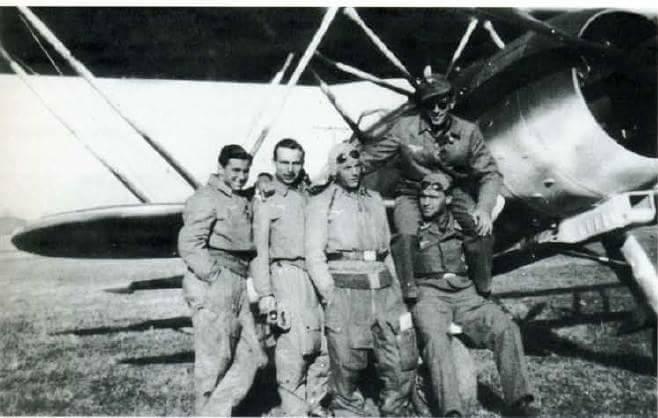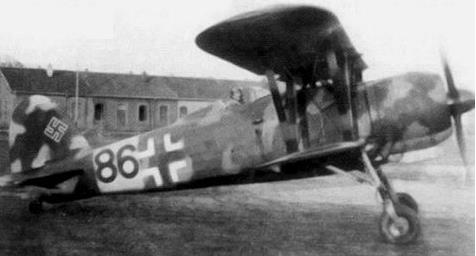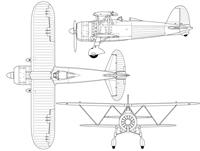CR.42AS
A close air-support version. The two standard 12.7 mm machine guns could be supplemented with two more. There were underwing racks for two 100 kg bombs. AS stands for 'Africa Settentrionale.' There was an additional engine filter to prevent damage from sand which caused a loss in power, a common occurrence in North Africa, since filter-less engines could be damaged after only a few hours use.
CR.42LW
Night harassment, anti-partisan aircraft for the German Luftwaffe. The aircraft were equipped with exhaust flame dampers, a pair of 12.7 mm machine guns and underwing racks for four 50 kg bombs. 150 were built, of which 112 were accepted into service by the Luftwaffe.







During the late 1930s, while a new generation of monoplane fighter aircraft were already beginning to be introduced across the various air services of Europe, there was still a considerable time before they would be developed and available enough to assume total responsibility for strategic air power operations.[8] By the outbreak of the Second World War during September 1939, many powers still fielded biplanes amongst their air wings, such as the British Gloster Gladiator and the Italian CR.42. As such, even as the first flights of the latter were being conducted during 1939, despite an acknowledgement of its effective obsolescence, it was also recognised that such biplanes would likely make a valued contribution in plentiful second-line roles.[8] This pragmatic observation turned out to be correct as not only would the CR.42 be built in greater numbers than any other Italian fighter of the war, it would also see action on every front in which the Regia Aeronautica fought upon.
The CR.42 was basically an evolution of the design of the earlier Fiat CR.32, which in turn had been derived from the CR.30 series created in 1932.[8] During the Spanish Civil War of the mid-1930s, the Regia Aeronautica had employed the CR.32 and had reportedly accomplished significant successes using the fighter. The positive combat experience gave sufficient encouragement to the type's principal manufacturer, Fiat Aviazione, for the company to produce a proposal for the development of a more advanced derivative of the design, incorporating the newly finalised supercharged Fiat A.74R1C.38 air-cooled radial engine and several other enhancements.[2] Key features of the fighter, which was designated as the CR.42, included its relatively clean aerodynamic exterior, a very strong structure, and a high level of maneuverability, a combination which had traditionally appealed to Italian pilots according to Cattaneo.
According to aviation author Gianni Cattaneo, both the proposal and the concept of a developed biplane was well received by the Regia Aeronautica, having placed a high value on the agility of the platform, confidence may have also been high due to prior wars in Ethiopia and Spain having been fought against relatively disorganised opposition, giving a somewhat deceptive impression of effectiveness. During its formal military evaluation, the prototype CR.42 was tested against the rival Caproni Ca.165 biplane fighter, and was judged to be the superior design, although the Ca.165 was a more modern design which boasted a higher speed, albeit at the cost of maneuverability. During flight tests, it demonstrated its ability to reach a top speed of 438 km/h at 5,300 m and 342 km/h at ground level. Climb rate was 1 minute and 25 seconds to 1,000 m and of 7 minutes and 20 seconds to 6,000 m
During late 1939, by which time a major European war already seemed inevitable, the CR.42 was ordered for the Regia Aeronautica. The type had been ordered as just a single element of the larger R plan, under which Italy was to procure 3,000 new fighter aircraft, such as the monoplane Fiat G.50 and the Macchi C.200, to equip and expand its air services. According to Cattaneo, at the outbreak of the Second World War, the CR.42 was considered to be the best biplane in service. Although the age of the biplane was noticeably already coming to a close by this point, a number of other foreign air forces expressed considerable interest in the new fighter. Once quantity production had been established, a number of early Falcos were delivered to foreign customers, even to the extent of re-directing aircraft originally intended for delivery to the Regia Aeronautica; these customers included Belgium, Hungary and Sweden.
Soon after its introduction to service, Fiat developed a number of variants of the type. The CR.42bis and CR.42ter featured increased firepower, while the CR.42CN was a dedicated night fighter model, the CR.42AS was optimised for performing ground attack missions, and the CR.42B Biposto commonly served in a twin-seat trainer role. Of these, the Biposto, which was furnished with a longer fuselage than other models to enable a second seat to be placed in tandem with the pilot, became the most extensively modified of all the CR.42 variants. Its length was increased by 68 centimeters over the standard fighter, to a total of to 8.94 m; the height was 23 centimeters less. Empty weight was only 40 kilograms more, as the wheel fairings had been removed. Overall weight was 2,300 kg. Top speed was 430 km/h at 5,300 meters, only 8 km/h less. Up to 1945, a pair of machine guns were commonly fitted. About 40 aircraft were produced by Agusta and Caproni Trento.
In addition, various experimental configurations of the CR.42 was both studied and constructed for trial purposes. These included the I.CR.42 (Idrovolante= seaplane) and the re-engined CR.42DB. Beginning in 1938, Fiat had worked on the I.CR.42, then gave the task to complete the project to CMASA factory in Marina di Pisa on the Tirreno sea coast. The only prototype was built in 1940. Tests started at the beginning of 1941, at the Vigna di Valle base, on Lake Bracciano, north of Rome. Top speed was 423 km/h, range was 950 km while ceiling was reduced to 9,000 m. Empty weight went from 1,720 to 1,850 kilograms , full weight from 2,295 to 2,425 kilograms
The CR.42DB was an attempt to improve the type's performance by installing a Daimler-Benz DB 601 V12 engine of 753 kW (1,010 hp). This prototype, MM 469, was flown by test pilot Valentino Cus in March 1941, over Guidonia Montecelio, near Rome. During test flights, it demonstrated its ability to attain a top speed of 518 km/h , as well as a maximum ceiling of 10,600 metres and a range of 1,250 kilometres . The project was cancelled as the biplane configuration did not offer any advantages over contemporary monoplane fighter designs. Although this variant never went into production, to the present day, the CR.42DB has continued to hold the distinction of being the fastest biplane to have ever flown.
Historians are still not certain exactly how many CR.42s were manufactured. The most likely estimate is thought to be 1,819 aircraft in total, including the 63 CR.42LWs produced under Luftwaffe control, and a further 140 fighters that were produced for the various export customers for the type.
The Fiat CR.42 was a robust and relatively clean single-seat biplane fighter aircraft; in spite of the biplane configuration of the aircraft, it was a modern, "sleek-looking" design, based around a strong steel and alloy structure. The CR.42 was furnished with fixed main landing gear, the legs of which were attached to the underside of the lower wing stubs; both the legs wheels were enclosed within streamlined fairings for aerodynamic reasons.[9] The upper wing was larger than its lower wing, a configuration known as a sesquiplane.[2] The aircraft proved to be exceptionally agile in flight, a characteristic which had been attributed to be a result of the fighter's very low wing loading. The very strong structure of the fighter enabled pilots to perform virtually all manoeuvres.] Shortcomings of the CR.42 included its slower speed in comparison to monoplanes, and a lack of armour, firepower and radio equipment.
The CR.42 was typically powered by a single supercharged Fiat A.74R1C.38 air-cooled radial engine which, via a gearing apparatus, drove a metal three-blade Fiat-Hamilton Standard 3D.41-1 propeller of 2.9 metres diameter. During the aircraft's development, particular attention was paid to the design of the NACA cowling which accommodated the engine; the cowling featured a series of adjustable flaps for cooling purposes. The engine bay incorporated a fire extinguisher to be used in the event of a fire.[9] In terms of armament, the early CR.42s were outfitted with a single 7.7 mm and one 12.7 mm Breda-SAFAT machine gun, which was installed in the decking of the upper fuselage and fired directly through the propeller. As per Italian tradition, a counter for the rounds fired was present amongst the cockpit's instrumentation.
The fuselage of the CR.42 was composed of a welded steel-tube triangulated framework built of light-alloy formers; while the forward fuselage was covered by metal panelling, fabric covered the exterior rear of the cockpit. The rigidly-braced wings used a structure that was constructed mainly of light duralumin alloys and steel; the leading edge was metal-skinned while the rest of the wing's exterior was covered with fabric. The upper wing, which was the only one to be furnished with ailerons, was joined in the center and supported above the fuselage via an inverted 'V'-shaped cabane, while the lower wings were directly attached onto the longerons within the base of the fuselage. The tail unit used a cantilever arrangement, composed of a duralumin framework and fabric covering.
| Type |
AS sinle seat close air-support |
LW single seat night harassment ant partisanaircraft |
| Engine |
1 Fiat A 74 R.C.38 with 3-bladed Fiat-Hamilton Standard 3D.41-1 propeller of 2.9 metres diameter. Variable-pitch propeller |
| Dimensions |
Length 8,25 m , height 3,585 m , span upper 9,7 m lower 6,5 m , wing area 22,4 m2 , |
| Weights |
Empty 1782 kg, loaded 2295 kg , max. take off weight |
| Performance |
Max. speed 441 km/h at 6100 m , cruising speed 399 km/h, landing speed 128 km/h , range 780 km , endurance , service ceiling 10210 m , climb 11,8 m/sec., take off run 210 m, landing run 340 m |
| Armament |
1 Breda SAFAT 7.7 mm and 1x Breda SAFAT 12.7 mm machine gun Later 2 x 12.7 mm Breda SAFAT machine guns, 400 rpg (most common).plus 2 12.7 mm machine guns in underwing fairing on some. Bombs: 200 kg on 2 wing hardpoints |






